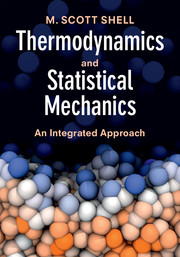Book contents
- Frontmatter
- Contents
- Preface
- Reference tables
- 1 Introduction and guide for this text
- 2 Equilibrium and entropy
- 3 Energy and how the microscopic world works
- 4 Entropy and how the macroscopic world works
- 5 The fundamental equation
- 6 The first law and reversibility
- 7 Legendre transforms and other potentials
- 8 Maxwell relations and measurable properties
- 9 Gases
- 10 Phase equilibrium
- 11 Stability
- 12 Solutions: fundamentals
- 13 Solutions: advanced and special cases
- 14 Solids
- 15 The third law
- 16 The canonical partition function
- 17 Fluctuations
- 18 Statistical mechanics of classical systems
- 19 Other ensembles
- 20 Reaction equilibrium
- 21 Reaction coordinates and rates
- 22 Molecular simulation methods
- Index
1 - Introduction and guide for this text
Published online by Cambridge University Press: 05 April 2015
- Frontmatter
- Contents
- Preface
- Reference tables
- 1 Introduction and guide for this text
- 2 Equilibrium and entropy
- 3 Energy and how the microscopic world works
- 4 Entropy and how the macroscopic world works
- 5 The fundamental equation
- 6 The first law and reversibility
- 7 Legendre transforms and other potentials
- 8 Maxwell relations and measurable properties
- 9 Gases
- 10 Phase equilibrium
- 11 Stability
- 12 Solutions: fundamentals
- 13 Solutions: advanced and special cases
- 14 Solids
- 15 The third law
- 16 The canonical partition function
- 17 Fluctuations
- 18 Statistical mechanics of classical systems
- 19 Other ensembles
- 20 Reaction equilibrium
- 21 Reaction coordinates and rates
- 22 Molecular simulation methods
- Index
Summary
Thermodynamics is a remarkable subject, both in its pervasiveness throughout the pure and engineering sciences, and in the striking simplicity and elegance of its principles. Indeed, it is hard to underestimate the significance of thermodynamics to virtually any physical problem of interest, even if its role appears only indirectly through derivative theories or models. As a testament to its importance, Einstein made the rather potent statement that thermodynamics is “the only physical theory of universal content concerning which I am convinced that within the framework of the applicability of its basic concepts, it will never be overthrown.”
At the same time, thermodynamics can be surprisingly difficult to grasp at a fundamental level, even for the experienced student. Unlike many other advanced scientific subjects, its main challenges are not mathematical in nature; a working knowledge of multivariate calculus is usually quite sufficient. Instead, the most difficult aspects of thermodynamics are its conceptual underpinnings. Students often struggle with the seemingly simple task of how to begin thinking about a problem, finding it difficult to answer questions such as the following. What constitutes the system? What is constant or constrained? What thermodynamic variables are equal across a boundary? What assumptions and models are reasonable? All of these questions precede the analytical analysis and are concerned with how to transform the physical problem into a mathematical one. When this is done, the solutions often present themselves in a rather straightforward manner, at least for an introductory treatment.
Information
- Type
- Chapter
- Information
- Thermodynamics and Statistical MechanicsAn Integrated Approach, pp. 1 - 5Publisher: Cambridge University PressPrint publication year: 2015
